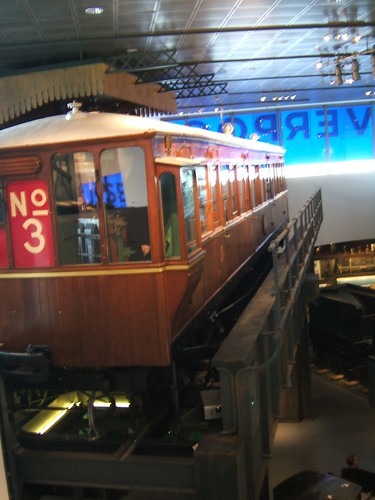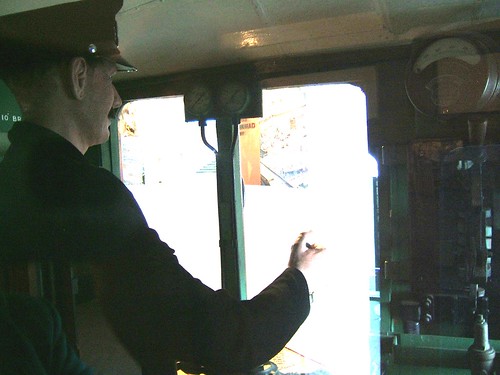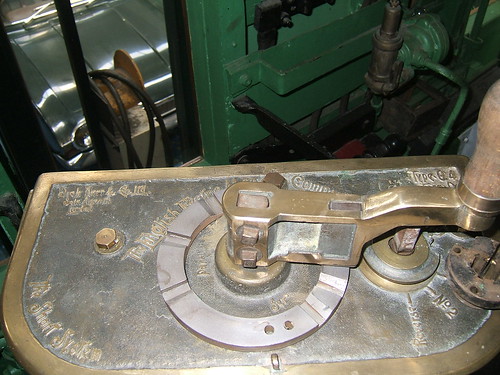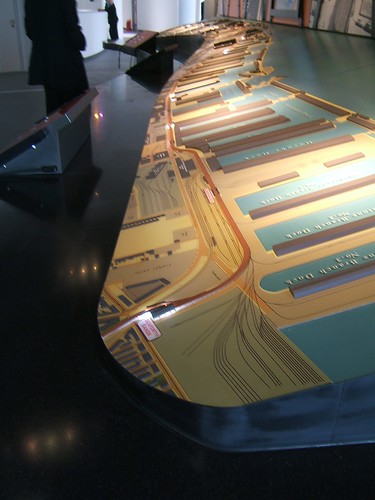 This panorama from the Liverpool Overhead Railway 'Map and Guide of the Railway and Docks' shows the route of the railway and the stations. Click on the image for a larger view.
This panorama from the Liverpool Overhead Railway 'Map and Guide of the Railway and Docks' shows the route of the railway and the stations. Click on the image for a larger view.
In the 1980s, I came across the preserved intermediate trailer coach of the pattern rebuilt by the Liverpool Overhead Railway at 'Steamport', which occupied the disused steam shed at Southport. The 'Steamport' operation subsequently relocated to Preston as The Ribble Steam Railway and I don't believe this coach survived.
Liverpool Museums originally had the preserved Driving/Motor car displayed in the Transport Gallery of the former museum but, when this closed, the coach was placed in storage. I caught up with this coach in 2010, described in my post here, whilst museum staff were preparing the vehicle for display in the new Museum of Liverpool. I was allowed to take a series of pictures.
I finally saw the Driving/Motor car displayed on 1st December 2011 when I was invited to attend the Official Opening of the new Museum of Liverpool, described in my post here. There are a few pictures of the car on display here.

The preserved Liverpool Overhead Railway driving motor car is displayed in the Museum of Liverpool in a setting representing the supporting girder structure and a station.
One bogie of each Driving/Motor car had a single 60 h.p. electric motor. Formation was normally 3-car with two Driving/Motor cars and a single Trailer car but, of course, 2-car operation was possible.
 Liverpool Overhead Railway coach: view of the driving compartment with (dummy) driver.
Liverpool Overhead Railway coach: view of the driving compartment with (dummy) driver.
 Top view of the Controller for the Traction Motors fitted in the driving compartment.
Top view of the Controller for the Traction Motors fitted in the driving compartment.
The controller now fitted appears to be more modern than that originally fitted. The cast brass top plate of the controller carries the name 'The English Electric Mfg. Co. Ltd', together with 'Dick Kerr & Co. Ltd, Sole Agents, London' and a cryptic reference to 'The Short System'. The type of the Controller is also marked on the top plate - Type Q4, Form D.
The Controller has two controls - the speed regulator is provided with a large, fixed handle whilst the master controller has a removeable handle which was moved from cab to cab when the driver 'changed ends' at the end of the line.
The speed regulator rotates from the one o'clock position (Off) through a number of 'Series' notches to five o'clock. Movement from five o'clock to eight o'clock places the motors in parallel and further notching up is possible, until the stop at eleven o'clock which should produce the maximum design speed of 30 m.p.h.Dick, Kerr & Company were taken over by English Electric in 1919 (see the Wikipedia articles on Dick, Kerr and Company and English Electric).
The master controller has a number of positions - Forward, No. 2, No. 1, Off, No. 1, No. 2, Reverse. I believe the 'No. 1' and 'No. 2' positions are to allow the set to continue with only one serviceable motor.
When first built, the trains had no air compressor and a trainborne air receiver was re-charged at the terminus. But later electric compressors were added. A 2-pipe system is fitted and the driver was provided with two air pressure gauges. The brake application valve was placed at the top of an upright branch pipe in the cab, in what I should think was a fairly inconvenient position. The driver was required to stand whilst driving.
The Museum of Liverpool display allows visitors to enter part of the coach and sound effects are provided. Additional information on the Liverpool Overhead Railway is presented adjacent to the coach and there is a splendid model of the route, where white lights (representing trains) move up and down the route, pausing briefly at each station.

The large model of the Liverpool Overhead Railway viewed from the Seaforth Sands end. The River Mersey is on the right.
Book References
[1] 'The Liverpool Overhead Railway 1893-1956' by Charles E. Box, revised by Adrian Jarvis, published Ian Allen (ISBN 0 7110 1183 4).
[2] 'The Docker's Umbrella: A History of the Liverpool Overhead Railway' by Paul Bolger, published by the Bluecoat Press (ISBN 1 872568 05 X).
[3] 'An Illustrated History of Liverpool's Railways' by Paul Anderson, published Irwell Press (ISBN 1-871608-68-6).
My pictures
Liverpool Overhead Railway Driving/Motor Car.
Royal Visit to the Museum of Liverpool.
